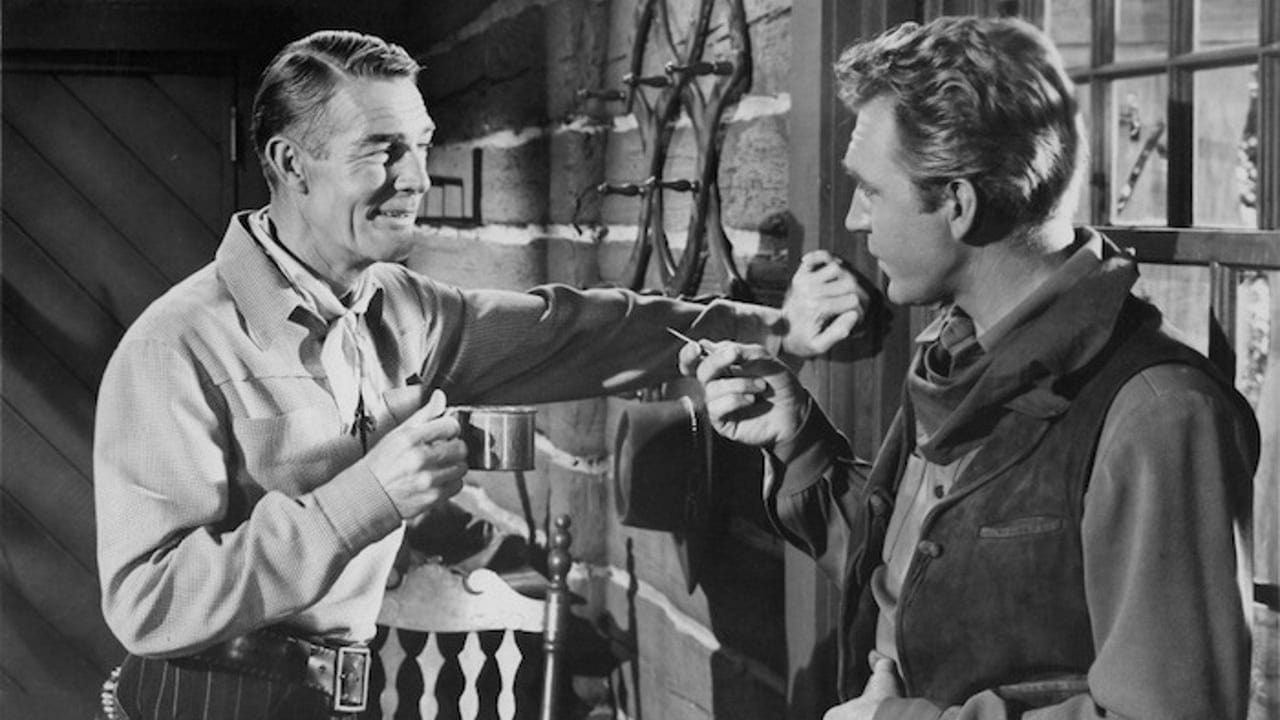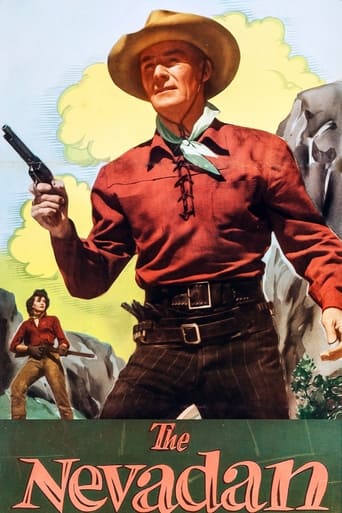Jeanskynebu
the audience applauded
Senteur
As somebody who had not heard any of this before, it became a curious phenomenon to sit and watch a film and slowly have the realities begin to click into place.
FirstWitch
A movie that not only functions as a solid scarefest but a razor-sharp satire.
ellenirishellen-62962
Agree with Ashew,Macready unfairly discounted in Westerns.He was definitely equal to a star like Randy Scott,and he was convincing as a Western heavy.Who else could direct a bunch of dopes to do his bidding?That he had good manners,dressed well,spoke with a commanding voice only made him more convincing as a brilliant man gone bad,perfect for any Western.This is his third movie opposite Scott,Coroner Creek when he's nastier to his wife than here,Doolins Of Oklahoma as a good lawman and the narrator,and The Stranger Wore A Gun.There's plenty of action and Dorothy Malone as Galt's daughter (pre Peyton Place for Malone and Macready)comedy with Faylen and Corey,additional menace from Tucker.I liked it!
Gary R. Peterson
A fun and exciting Western that entertains as much today as it did in wintry early 1950 when it was first released.After enjoying the film on a Saturday morning, which is the best time to enjoy films like THE NEVADAN, I read all 15 reviews posted here. Many are eager to point out how this humble film pales in comparison to the Westerns of Boetticher, Mann, and Peckinpah, lacking as it does deep psychological themes and Method actors wringing their hands and contorting their faces in painful introspection. There's an unwillingness or perhaps an inability to consider THE NEVADAN on its own merits. It's only aspiration was to entertain--and it succeeded.Now I'm not casting stones or even aspersions. I count myself among the guilty, admitting I too am unable to see this film wholly on its own. Each of us brings to the movie-going experience all we've already seen, and most people watching a 1950 Western are aging cinephiles bringing a LOT to the experience. For me, Forrest Tucker will always stir up fond memories of Sgt. Morgan O'Rourke. And when Jeff's dimwitted brother Bart pulled another boner, I was just waiting for Frank Faylen to look into the camera and mutter, "I gotta kill that boy; I just gotta" like he would a decade later on DOBIE GILLIS. Those associations added to my enjoyment.Speaking of Faylen and Jeff Corey as brothers Jeff and Bart, I suspect they were loosely based on brothers George and Lennie from John Steinbeck's 1937 novella Of Mice and Men. The script and the actors elevated Jeff and Bart far above the expendable and disposable "red shirt" henchmen of lesser Westerns. I can also see in them a foreshadowing of the memorable and scene-stealing Sam and Whit, the duo played by Pernell Roberts and James Coburn in RIDE LONESOME.The closing gunfight with Andy and Tom against Galt, Jeff, and Bart was a highlight, topped only by Andy and Tom's brawl to end it all in the collapsing mine. Karen's appearance added to the excitement, even as it allowed Tom to remind us he's the bad guy when he shoots Galt in the back. Jeff's ruthlessly shooting the mules and canteens showed the depth of his depravity, and lessened the regret I felt when he took a bullet to the brain (a surprisingly graphic scene for 1950, I thought).The grimness is balanced by lighthearted moments. An uncredited Nacho Galindo is funny as an apoplectic stagecoach driver. Also unbilled are Olin Howard and Lewis Mason as Rusty and Wilbur, two cowpokes straight out of a 1930's programmer who look for a laugh from supposed greenhorn Andy and get egg on their faces. It's a funny scene, but also serves as good character development as the audience is made aware that Andy is not the dapper tenderfoot he initially appeared to be.I saw THE NEVADAN as one of six films on Mill Creek's second Randolph Scott Round-Up DVD collection. The print is beautiful, the colors rich, and the price right--only about ten bucks! Slip it in on a Saturday morning and "forget about life for awhile," as Billy "the Kid" Joel once sang.PS: The gold fever that drove Galt to greed-driven madness and violence is a recurring theme in Westerns. No film captures it as well as A MAN CALLED SLEDGE, an under-appreciated 1970 film directed by Vic Morrow and starring James Garner, Dennis Weaver, and Claude Akins among others familiar faces to film and TV fans.
ashew
This movie just begins the transition from the old, cartoonish Scott Westerns and the more adult Boetticher films...they were getting there, but just not there yet. This movie is still very heavy on the one-dimensional characters and you won't find any Method acting, but Randolph Scott had aged just perfectly by this point...the lines in his face providing a mature ruggedness...no more matinée idol good looks...just a weather-beaten cowboy. His acting isn't very good in this one, but he always looked the part of the hero (except for the hat he wears in the beginning of the film...impossible to take him seriously in that ridiculous thing).The IMDb critics, as well as many legitimate critics, pile on top of poor George Macready, complaining that he didn't belong in Westerns. The problem with these poor misguided folks is that they expect a Western to only contain southern accents. Our land was settled by those from all over the UK, Europe, and beyond, so the fact that George Macready has the speech pattern and accent that he does would actually be MORE accurate for the time period, not less. And how can anyone complain about him as the bad guy when his normal speaking voice was so phenomenal and unique...the man literally sounds like a snake! He's a fine actor and I always enjoy watching him.Although Forrest Tucker does a fairly good job throughout, the bulk of the supporting cast all give performances that never ring true. The best actor in the whole movie? Dorothy Malone. I was really surprised at how good she was. I had only ever seen her as a blonde, so I almost didn't recognize her as a brunette...and so young and innocent! She looked absolutely beautiful, and gave a uniformly good and honest performance.I'm a guy who likes my action films undiluted with dopey love stories, but I must say that the scenes between Scott and Malone were excellent...they had some real chemistry...and I think because Ms. Malone was such a good actress, she raised Scott's performance up to where it should have been throughout. ***QUASI-SPOILERS COMING UP*** The problem is, they never hug, never kiss, never fall in love in a way that means anything...always from a distance. Their chemistry was really wasted. He doesn't even say goodbye to her at the end of the movie and she has a dopey line to let the audience know he'll be back!! That was a big let-down.Unless you're a die-hard Randolph Scott fan, or want to get an eyeful of an adorable Dorothy Malone, I would suggest letting this film go by. The best of the Scott films are: The Tall T, Ride Lonesome, Seven Men From Now, and Comanche Station...those are guaranteed to entertain.
Robert J. Maxwell
Unexceptional Westerns like this one almost always followed certain well-worn conventions. A few clips on the jaw and a man was unconscious. Men wore nondescript generic Western clothing, usually including a vest. The capo may have a string tie, possibly a suit, but most of the men wore neckerchiefs which were never used, as well as guns, which were. The girl friend was pure, although maybe mixed up. There was little in the way of character development and motivations were usually simple, as Galt's is here -- "gold fever", someone calls it. They were usually shot at a studio ranch or at Lone Pine or, as in this case, in both.Later in the 1950s ambitious directors like Anthony Mann introduced some life into the increasingly tired comic-book stories by giving us heroes who were neurotic and subsidiary characters with complicated motives. Other directors simply gave up trying and turned the cartoon into a parody, like one of those Steig cartoons in which a hand is seen drawing itself. Budd Boetticher was a director who gave up and reveled in the primitivism of the form.That's when Randolph Scott made the Westerns he's best known for, like "Ride Lonesome." Great title there. Scott's character was reduced to a prig, as morally upright as a gastropod on its poduncle, always putting temptation behind him, never telling a lie, rejecting offers of warmth and comfort from women -- a total bore, in other words. "The Nevadan" had the same producers as the later Boetticher films but Scott's character hadn't quite hardened into the inflexible clunk yet. He smiles here. He fibs too. He only shoots one guy, and not by outdrawing him either. It's an improvement over his later persona. But the villains aren't. Boetticher's villains were great -- Lee Marvin, Richard Boone, Pernell Roberts, James Coburn. The heavies here are not nearly as much fun. How can anyone take George MacReady seriously as a Western head heavy? He belongs in a corporation as part of a conspiracy. Faylen still sounds like the taxi driver in "Dark Passage." Ray Corey is supposed to have been a well-regarded drama teacher later on, and he gave a flawless performance in "In Cold Blood," but he brings nothing to the party here as a dull-witted joke. But the woman, Dorothy Malone, has never looked better, fresh faced, young, and innocent, as MacReady's daughter. Hollywood had a habit of glamorizing her to the point of unrecognizability. They gave her glossy hairdos, slick lips, two tons of pancake or waffle makeup, and false eyelashes the size of those canvas tarps you put up as extensions of your mobile home. She's a surprise. Nobody else in this movie is.
But it's also worth mentioning Jock Mahoney as "Sandy," one of the bad guys. He was as homely as they come, but the man's physical presence was magnetic. I'm sure he didn't deliberately try for the effect but every swift movement was as graceful as a dancer's, the opposite of John Wayne who seemed to move by putting one or two limbs in motion and letting his torso follow them sometime later on. One example: watch the scene in which Malone gives Mahoney's horse a kick in the hindquarters and Mahoney finds himself splashing down into a creek, then spins the horse around and climbs the bank as if man and animal were one being, just as the Aztecs thought.

